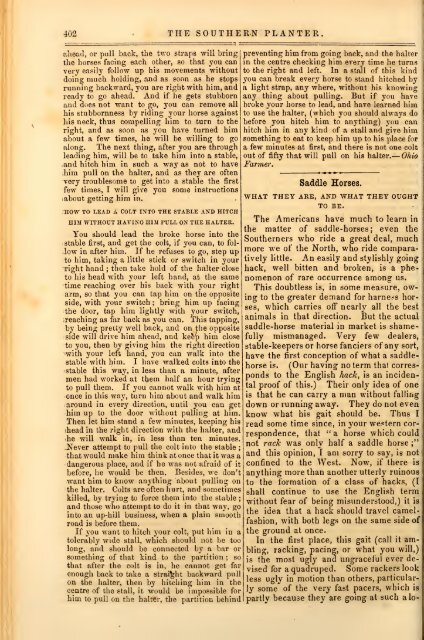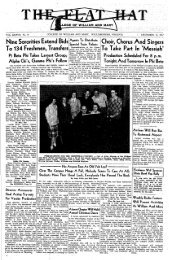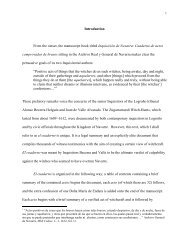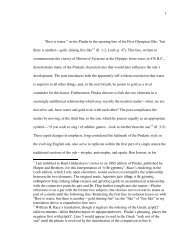Southern planter : devoted to agriculture, horticulture, and the ...
Southern planter : devoted to agriculture, horticulture, and the ...
Southern planter : devoted to agriculture, horticulture, and the ...
Create successful ePaper yourself
Turn your PDF publications into a flip-book with our unique Google optimized e-Paper software.
402 THE SOUTHER.N PLANTER<br />
ahead, or pull back, <strong>the</strong> two straps will bring<br />
<strong>the</strong> horses facing each o<strong>the</strong>r, so that you can<br />
very easily follow up his movements without<br />
doing much holding, <strong>and</strong> as soon as he s<strong>to</strong>ps<br />
running backward, you are right with him, <strong>and</strong><br />
ready <strong>to</strong> go ahead. And if he gets stubborn<br />
<strong>and</strong> does not want <strong>to</strong> go, you can remove all<br />
his stubbornness by riding your horse against<br />
his neck, thus compelling him <strong>to</strong> turn <strong>to</strong> <strong>the</strong><br />
right, <strong>and</strong> as soon as you have turned him<br />
about a few times, he will be willing <strong>to</strong> go<br />
along. The next thing, after you are through<br />
leading him, will be <strong>to</strong> take him in<strong>to</strong> a stable,<br />
..<strong>and</strong> hitch him in such a way as not <strong>to</strong> have<br />
:him pull on <strong>the</strong> halter, <strong>and</strong> as <strong>the</strong>y are often<br />
very troublesome <strong>to</strong> get in<strong>to</strong> a stable <strong>the</strong> first<br />
few times, I will give you some instructions<br />
about getting him in.<br />
JHOW TO LEAD A COLT INTO THE STABLE AND HITCH<br />
HIM WITHOUT HAVING HIM PULL ON THE HALTER.<br />
: stable<br />
You should lead <strong>the</strong> broke horse in<strong>to</strong> <strong>the</strong><br />
first, <strong>and</strong> get <strong>the</strong> colt, if you can, <strong>to</strong> fol-<br />
jIow in after him. If he refuses <strong>to</strong> go, step up<br />
"<strong>to</strong> him, taking a little stick or switch in your<br />
Tight h<strong>and</strong> ; <strong>the</strong>n take hold of <strong>the</strong> halter close<br />
<strong>to</strong> his head with your left h<strong>and</strong>, at <strong>the</strong> same<br />
'time reaching over his back with your right<br />
arm, so that you can tap him on <strong>the</strong> opposite<br />
side, with your switch; bring him up facing<br />
<strong>the</strong> door, tap him lightly with your switch,<br />
^reaching as for back as you can. This tapping,<br />
by being pretty well back, <strong>and</strong> on <strong>the</strong> opposite<br />
side will drive him ahead, <strong>and</strong> ke^p him close<br />
<strong>to</strong> you, <strong>the</strong>n by giving him <strong>the</strong> right direction<br />
with your left h<strong>and</strong>, you can walk in<strong>to</strong> <strong>the</strong><br />
stable with him. I have walked colts in<strong>to</strong> <strong>the</strong><br />
^stable this way, in less than a minute, after<br />
men had worked at <strong>the</strong>m half an hour trying<br />
<strong>to</strong> pull <strong>the</strong>m. If you cannot walk with him at<br />
once in this way, turn him about <strong>and</strong> walk him<br />
; around in every direction, until you can get<br />
him up <strong>to</strong> <strong>the</strong> door without pulling at him.<br />
Then let him st<strong>and</strong> a few minutes, keeping his<br />
ihead in <strong>the</strong> right direction with <strong>the</strong> halter, <strong>and</strong><br />
ihe will walk in, in less than ten minutes.<br />
.Never attempt <strong>to</strong> pull <strong>the</strong> colt in<strong>to</strong> <strong>the</strong> stable ;<br />
that would make him think at once that it was a<br />
dangerous place, <strong>and</strong> if he was not afraid of it<br />
before, he would be <strong>the</strong>n. Besides, we don't<br />
want him <strong>to</strong> know anything about pulling on<br />
<strong>the</strong> halter. Colts are often hurt, <strong>and</strong> sometimes<br />
killed, by trying <strong>to</strong> force <strong>the</strong>m in<strong>to</strong> <strong>the</strong> stable ;<br />
<strong>and</strong> those who attempt <strong>to</strong> do it in that way, go<br />
in<strong>to</strong> an up-hill business, when a plain smooth<br />
road is before <strong>the</strong>m.<br />
If you want <strong>to</strong> hitch your colt, put him in a<br />
<strong>to</strong>lerably wide stall, which should not be <strong>to</strong>o<br />
long, <strong>and</strong> should be connected by a bar or<br />
something of that kind <strong>to</strong> <strong>the</strong> partition ; so<br />
that after <strong>the</strong> colt is in, he cannot get far<br />
enough back <strong>to</strong> take a straight backward pull<br />
on <strong>the</strong> halter, <strong>the</strong>n by hitching him in <strong>the</strong><br />
centre of <strong>the</strong> stall, it would be impossible for<br />
him <strong>to</strong> pull on <strong>the</strong> halter, <strong>the</strong> partition behind<br />
preventing him from going back, <strong>and</strong> <strong>the</strong> halter<br />
in <strong>the</strong> centre checking him every time he turns<br />
<strong>to</strong> <strong>the</strong> right <strong>and</strong> left. In a stall of this kind<br />
you can break every horse <strong>to</strong> st<strong>and</strong> hitched by<br />
a light strap, any where, without his knowing<br />
any thing about pulling. But if you have<br />
broke your horse <strong>to</strong> lead, <strong>and</strong> have learned him<br />
<strong>to</strong> use <strong>the</strong> halter, (which you should always do<br />
before you hitch him <strong>to</strong> anytliing) you can<br />
hitch him in any kind of a stall <strong>and</strong> give him<br />
something <strong>to</strong> eat <strong>to</strong> keep him up <strong>to</strong> his place for<br />
a few minutes at first, <strong>and</strong> <strong>the</strong>re is not one colt<br />
out of fifty that will pull on his halter.— Ohio<br />
Farmer,<br />
Saddle Horses.<br />
WHAT THEY ARE, AND WHAT THEY OUGHT<br />
TO BE.<br />
The Americans have much <strong>to</strong> learn in<br />
<strong>the</strong> matter of saddle-horses; even <strong>the</strong><br />
<strong>Sou<strong>the</strong>rn</strong>ers who ride a great deal, much<br />
more we of <strong>the</strong> North, who ride comparatively<br />
little. An easily <strong>and</strong> stylishly going<br />
hack, well bitten <strong>and</strong> broken, is a phenomenon<br />
of rare occurrence among us.<br />
This doubtless is, in some measure, owing<br />
<strong>to</strong> <strong>the</strong> greater dem<strong>and</strong> for harne.
















